I’m Dr. Fatema Ferdousee, the Medical Team Leader for the Hepatitis C project in Balukhali. Viral hepatitis, particularly types B and C, is a global health crisis, tragically claiming over 1.3 million lives annually. The situation here in Rohingya refugee camps in Cox’s Bazar is even more dire. Overcrowded conditions and limited access to healthcare have created a perfect storm for its spread. A recent MSF study indicates a shocking reality: nearly 20% of Rohingya refugees tested in these camps have an active hepatitis C infection.
We, the Balukhali team of MSF, are conducting screening and testing at three specific camps: Camp 9, Camp 8E, and Camp 10. Our estimated target population is around 57,000 people, and our mission is to screen them all, providing vital Hepatitis C services.
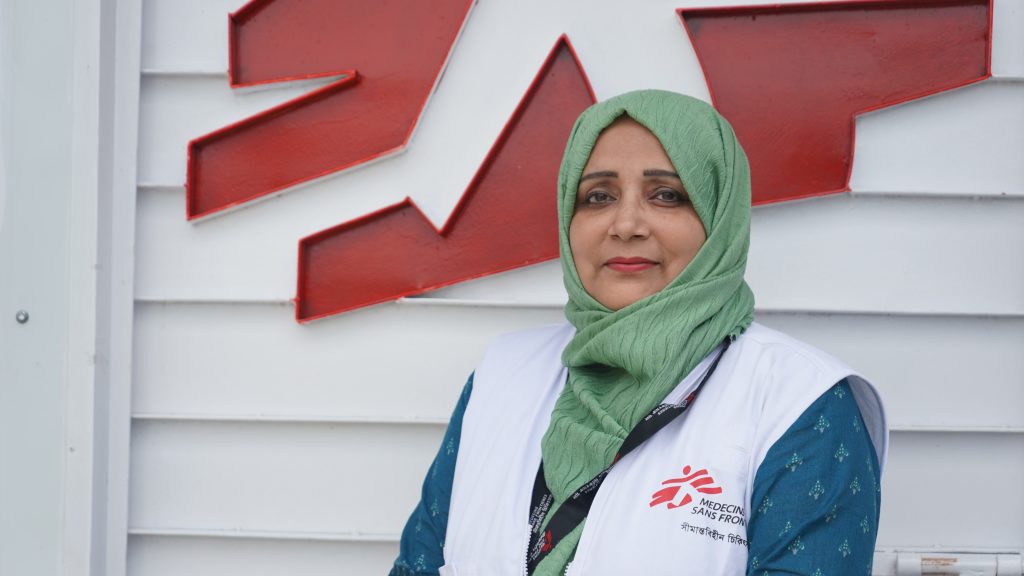
I refer to Hepatitis C as a “silent killer” because, in many cases, it presents with no obvious signs or symptoms. People can be infected for years, even decades, without knowing it. Sometimes, there might be very mild, flu-like symptoms such as a slight fever, nausea, or vomiting, but often, nothing at all. This insidious nature means that over time, the virus gradually damages the liver, leading to severe conditions like cirrhosis or even liver cancer. Because symptoms don’t appear early, many people don’t seek testing or treatment until it’s too late.
To combat this, our team is focusing on three critical areas: raising awareness, providing comprehensive testing and treatment, and breaking down the associated stigmas.
Our goal for raising awareness is to actively inform the community about Hepatitis C, explaining the risks and emphasizing the crucial importance of seeking early treatment.
When it comes to testing and evaluation, MSF teams conducted 12,000 tests between 2020 and 2024. Then, the Balukhali team specifically began testing in mid-May (2025). In this short time, we’ve already screened 2,275 people, and 496 individuals tested positive with the initial screening. This is just the first step. We are ensuring that those diagnosed receive treatment.
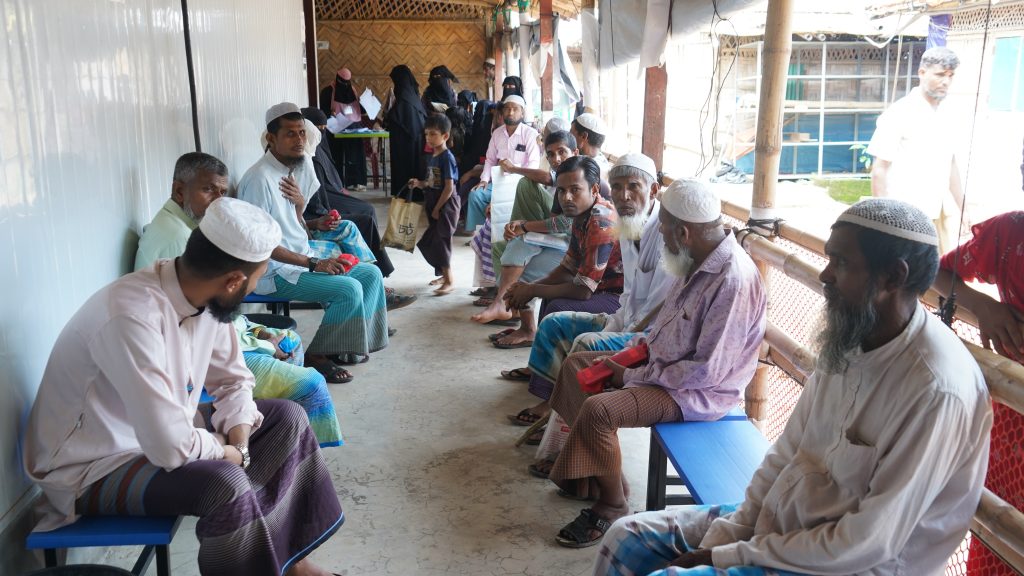
Our third crucial area is breaking down stigma. We have an incredible team working in the field every morning. This team of 23 people, including 16 community-based health volunteers (with two team leaders) and five nurses, goes door-to-door in the camps. During their visit they conduct tests and provide essential health education about Hepatitis C. They explain what the disease is, how it can harm individuals, and clarify that an RDT-positive result means further testing and potential treatment.
The community’s feedback and support have been overwhelmingly positive. Many people have been waiting for this treatment for a long time. Given the limitations of healthcare and the lack of government-level treatment options, many were anxious about when they would ever receive care. When our teams go into the community, they are almost always cordially received, and people are eager to talk.
There are some minor challenges, though. For example, a fear sometimes exists within the community that if someone tests positive, it might pose difficulties for marriage or lead to social ostracization. However, this is not widespread. For the most part, when individuals are given proper health education, they understand. Because there are no symptoms, unlike a fever that would immediately send someone to the clinic, people don’t feel acutely ill. Yet, they understand the implications and the cost of treatment, knowing they cannot afford it. They are keen to receive treatment through our program. Our health educators and volunteers tirelessly explain how the disease spreads: not through casual contact, but through blood-to-blood contact.
This fight against Hepatitis C requires a collective effort. It cannot be prevented by one person alone. Especially in this densely populated community, I believe that by sharing the awareness I’ve gained today, we can reach everyone. Our ultimate goal is to eliminate Hepatitis C in the Rohingya refugee camps by expanding testing, treatment, and awareness. By doing so, we can significantly improve health outcomes and create a brighter future for this entire community.
It’s been three long years since I’ve been living with Hepatitis C. I first found out about it when I visited a hospital in the Balukhali Paanbazar area for some physical difficulties I was experiencing. Back then, even though access to Hepatitis C treatment was technically available somewhere, I couldn’t do much about it. I just felt sick and had to live with that feeling for three years.
The treatment for Hepatitis C costs a lot of money, and we simply don’t have that kind of money. So, I couldn’t seek medical treatment and was forced to wait.
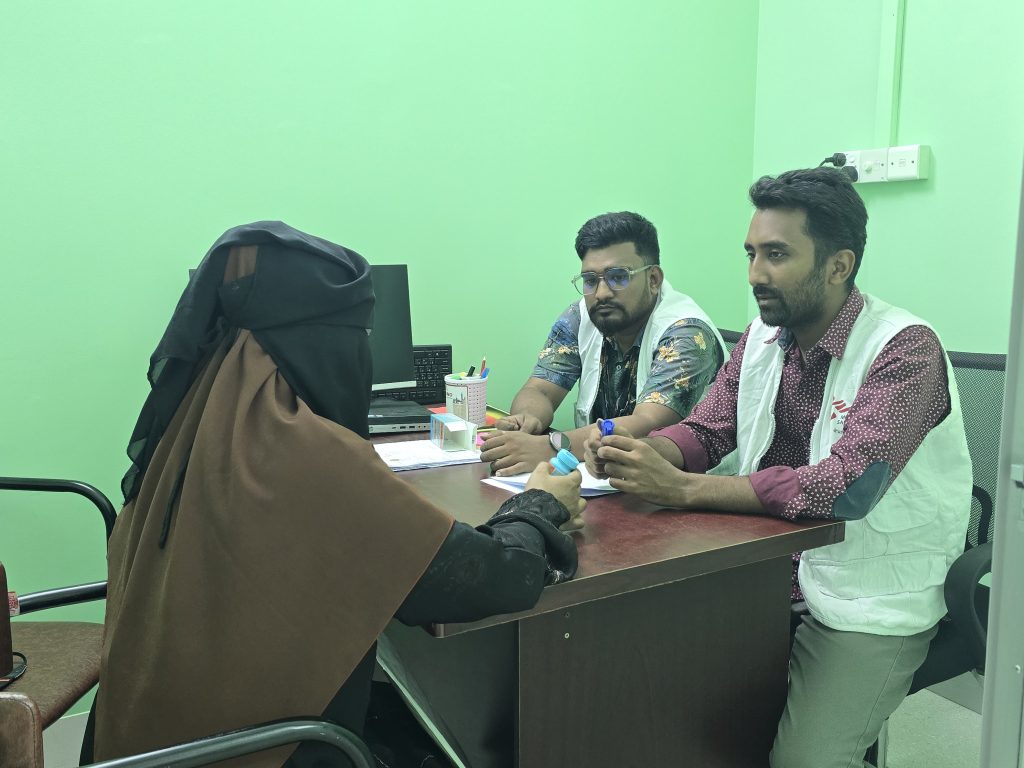
Then, recently, everything changed. MSF teams visited our homes and screened us for Hepatitis C. My result came back positive, and that’s when I was asked to visit MSF’s Balukhali facility. Finally, I received the medication I desperately needed. When I got the medicine, I felt such immense relief, thinking about the possible cure for this disease. It’s truly a new beginning for me,” says Rofika, a Rohingya refugee from Cox’s Bazar Rohingya Refugee Camp, Bangladesh.
My name is Shohiedol. I came to Bangladesh along with my family members because of the severe oppression we faced in my home country, Myanmar. We were forced to leave everything behind due to this relentless persecution.
In 2017, the area where I lived in Haritala, Maungdaw, was not affected by the conflict. But the violence that broke out in 2023 forced us to flee. My mother was shot in the leg. That’s when we decided to leave. We moved to Bangladesh in 2024, hoping to find safety here. I came with my parents, my sister, my grandmother, and many of our neighbors.
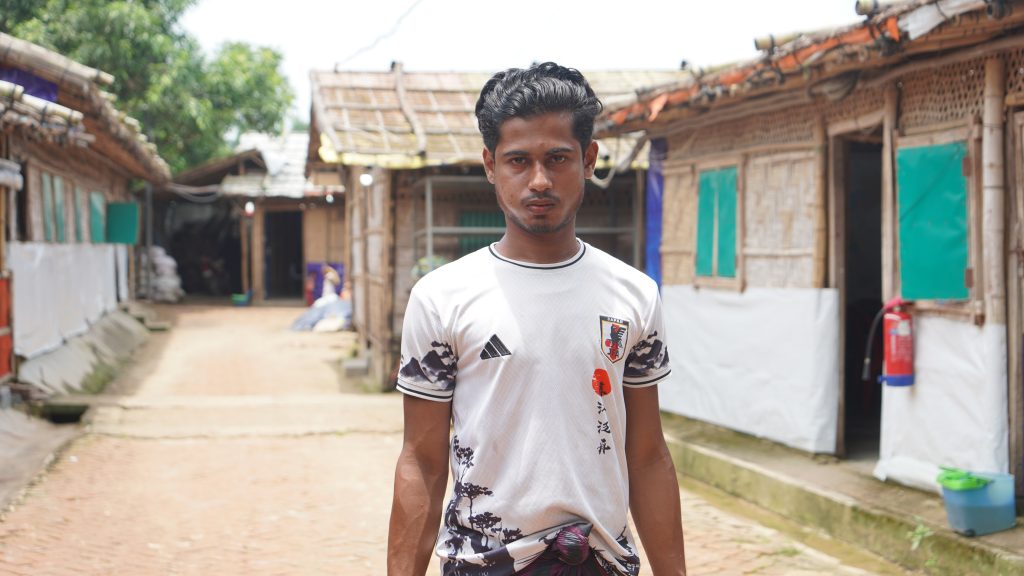
Recently I have been feeling very weak and tired. When a health promotion team of MSF visited my house, they did a blood test, and that’s when I discovered that I have a hepatitis C infection. They tested everyone in my family, and later I was told to come to the MSF Jamtoli clinic to collect reports. After the doctor’s checkup, they gave me medicine for the hepatitis C infection. I’ve been feeling much better since I started taking it.
Before I started the medicine, I used to feel dizzy when I stood up, I’d get tired just walking, I had chest pain, and I didn’t feel like eating. Since taking the medicine, these problems have been decreasing. I didn’t know about these symptoms before the MSF team visited my home and explained them to me.
While I lived in Myanmar, I had no idea I had this disease, even though I experienced some of these symptoms. I never had a blood test there. It was only after coming here and getting checked by MSF that I understood what I was suffering from.
The doctor told me I need to take medicine for three months. They gave me a month’s supply initially, which I’ve already finished, and now I’m back for more medication.
When I found out I had hepatitis C, I wasn’t scared. I kept myself strong, thinking that if God gave me this disease, then God will cure it.
My name is Nazmul Hoque, and I’m a medical assistant with MSF.
When a patient is first diagnosed with hepatitis, they are seen by a medical doctor who provides their initial prescription of medicines. As medical assistants, we play a crucial role in patient consultation and managing their follow-up appointments. We monitor their medication adherence, check for any new health issues or complications, and take appropriate steps. We also inform them about their next appointment and provide crucial reminders about the treatment regimen they need to follow for Hepatitis C. We counsel them when they start treatment and reiterate these instructions at each follow-up. Crucially, we also explain to them how to prevent further transmission of Hepatitis C infection.

One of the biggest challenges here in the community is the common practice of visiting informal healthcare providers for injections and saline drips. When people feel weak or can’t eat, they often believe that getting saline or glucose injections will make them feel better. We strongly advise against this. These providers are often not formally trained, and they can reuse the same needle for multiple people—sometimes up to four or five individuals. This practice is a major driver for the spread of bloodborne diseases like hepatitis C, HIV, and hepatitis B. By counseling them to avoid these unsafe practices, we are trying to close a major root of infection or transmission.
Our outreach and health promotion team conducts door-to-door screening with rapid diagnostic tests (RDT) for Hepatitis C after providing complete information about the tests and possible results. If a screening test comes back positive, our nurses then collect samples for polymerase chain reaction (PCR) testing. These samples are carefully stored in iceboxes and transported to our hospital for a confirmatory test. Patients are requested to come the very next day to collect their reports. Patients with a negative PCR receive comprehensive counseling about their results and preventive methods, and those who tested positive are consulted by a doctor for treatment.
Awareness related to Hepatitis C infection has vastly improved since this “test and treat” campaign was launched. Before this campaign, we used to have strict criteria for Hepatitis C treatment. We had limited stocks of hepatitis C oral medicine, and patients who were hepatitis C positive but asymptomatic and with no liver dysfunction couldn’t receive treatment. They were asked to wait for the next assessment, which was incredibly disheartening for them. Their financial situation also prevented them from seeking treatment outside the camp, and movement is restricted anyway. So, they were left to live with the disease.
In the beginning, many patients would share how their parents and other family members had been infected with Hepatitis C but had never received any treatment. Now, they are receiving it. While previously they had no knowledge of the spread and risk factors of Hepatitis C, our counseling sessions are now providing them with a comprehensive understanding about the disease.
It’s important to note that the national prevalence of Hepatitis C in Bangladesh is estimated to be around 1% – 3% of the general population, making effective prevention and treatment crucial for everyone.*
To break the chain of hepatitis C transmission within the Rohingya camps, treatment must go hand-in-hand with prevention. This means ensuring universal access to safe medical practices—like sterile injections and blood transfusions—and empowering the community with health information on transmission risks and hygiene practices.
I’m Dr. Farhana Yesmin, and I’ve been working on the Hepatitis C project at Hospital on The Hill (HoH) Camp 8W since March 2025. Every day, I see firsthand the silent struggle of so many, a struggle that often goes unnoticed until it’s too late. But I also see immense hope, fueled by the dedication of our teams and the incredible resilience of our patients.
Here at HoH, our focus is on providing comprehensive treatment for hepatitis C and addressing its related complications. We’re on the front lines of a major health challenge. The rate of hepatitis C infection in these camps is alarmingly high, which is precisely why MSF launched our intensive “test and treat” campaign.
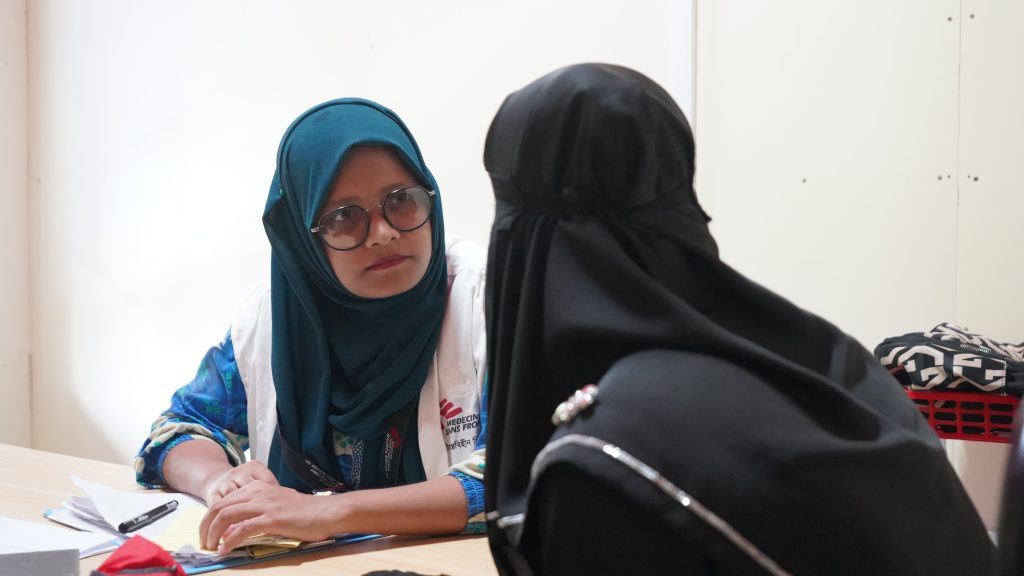
The numbers tell a stark story. So far, we’ve screened nearly 12,000 people out of our target of just over 12,700. The positivity rate stands at a concerning 19%, meaning we’ve identified 2,136 individuals who are positive for hepatitis C. We’ve already started treatment for 2,102 of them. It’s a massive undertaking, but each person treated is a life changed.
We’ve observed that many people simply don’t know they have hepatitis C because it often shows no symptoms for years. When we deliver a new diagnosis, it can be a shock, but it also opens the door to life-saving treatment. The more we test, the more we find, and the more lives we can save.
Working in this context, we definitely face a unique set of challenges. We encounter patients who, in addition to hepatitis C, are co-infected with other serious conditions like hepatitis B, HIV, or tuberculosis. When we refer them for follow-up testing for these conditions—whether it’s in three or six months—they can understandably become distressed about not receiving immediate treatment for all their ailments. It’s a challenge to manage their expectations and reassure them that comprehensive care is coming
For those diagnosed with hepatitis C, there’s a general sense of relief and happiness that treatment is finally available for a disease that previously had no local solution. In our clinic, we provide one-on-one counseling to ensure they feel comfortable and can speak freely. On a positive note, families are often very supportive; if one member tests positive, they are often keen to bring other family members, including children aged 11-17, for testing. This willingness to seek testing as a family unit is a positive step towards broader prevention.
A significant improvement in our service has been the change in age restrictions for treatment. Previously, we couldn’t treat anyone under 40, which meant many younger individuals, like the wives of positive patients, were left without care. Now, we’re able to treat patients from 11 years old and above, significantly expanding our reach and ensuring more people get the life-saving medication they need.
My name is Nur and I’m 30 years old. I’m at the clinic because I had a blood test, and they asked me to come back at 10 o’clock in the morning to get the second report. I’ve been here for quite some time, waiting.
Yes, I received my Hepatitis C report and it came out that I have Hepatitis C. The good news is, I’m going to get medicine for it! They told me to get a health card for the treatment, which is a relief. When I first heard the news that I had hepatitis C, I was filled with fear. I knew nothing about this disease, and I’ve never really taken medicine before in my life. I’m a mother of four, and I’ve always considered myself healthy. I didn’t have any symptoms, no pain, no body aches. That’s why, when they told me after the blood test, it was such a shock. I never knew I had this disease because it showed no signs.
It turns out I’m not the only one in my family. My husband also has Hepatitis C. He also visited the clinic with me.
We had a hepatitis C test about a year ago, when my father-in-law passed away. But at that time, our results weren’t positive. We had never been tested before then. So, I don’t know if anyone else in my extended family, beyond my immediate household, has it. I have four brothers-in-law and four sisters-in-law living together and four unmarried brothers-in-law. After this recent round of testing, it was discovered that I, my husband, one of my sisters-in-law, and my mother-in-law all have the hepatitis C virus.
We’ve been living in Bangladesh for eight years now. I’ve been married for a long time; I got married back in my country, Myanmar.
My two elder sons were born in Burma [Myanmar], both at home with the help of my mother and traditional birth assistants. My mother was a great support, helping with daily activities, cooking, and taking care of the children. My two younger children were born here in Bangladesh, also at home. My mother is older now and can’t help as much, so my elder sister came to stay with us for the deliveries and assisted throughout the whole process. Once I recovered, she returned to her own home in Jamtoli.
Today, after coming to the clinic, I learned a lot about how Hepatitis C spreads from the counselors. They explained that it’s mainly through blood-to-blood contact. For example, if a razor blade used for shaving is reused, or if injectable medicine is given in local pharmacies or by rural doctors using the same needle for multiple people, the disease can spread. It can also spread through shared nail clippers or other personal items that might have come in contact with blood. I also learned that sharing food with an infected person does not spread it, which is reassuring.
Given this information, I’ve wondered if I might have contracted it during the birth process, particularly as my children were born at home here without immediate access to formal medical facilities. But honestly, I still don’t know how I got it. I’ve been involved in so many kinds of work, and I can’t pinpoint how I might have contracted it.












